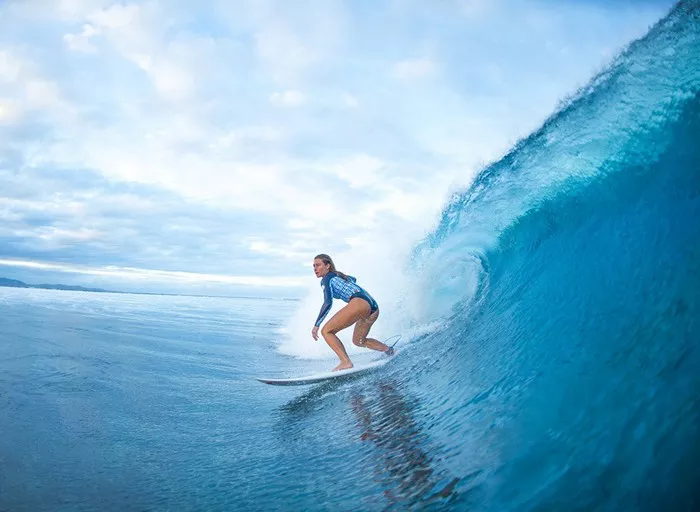In the world of surfing, back paddling is a fundamental skill that can significantly enhance a surfer’s ability to catch waves and maneuver effectively in the lineup. While paddling out towards the waves is a common aspect of surfing, back paddling involves moving backward on the surfboard to reposition or to catch a wave that has already passed underneath. This technique is essential for surfers of all levels, from beginners learning the basics to advanced riders seeking to fine-tune their wave-catching abilities.
Body Positioning: The Foundation of Efficient Back Paddling
Proper body positioning is crucial for successful back paddling. The goal is to maintain balance and control while moving backward on the board. Here’s how to achieve the correct posture and weight distribution:
1. Positioning on the Board: Lie face down on your surfboard, centered between the nose and tail. Keep your body relaxed but engaged, with your chest slightly raised off the board for better visibility and control.
2. Weight Distribution: Distribute your weight evenly across the board to maintain stability. Avoid leaning too far forward or backward, as this can affect your maneuverability and control.
3. Feet Placement: Keep your feet together and flat on the board. Your toes can lightly grip the board for additional stability, but avoid excessive tension in your legs.
By maintaining a balanced and centered posture, you’ll be prepared to execute efficient back paddling strokes.
Arm Movements: Perfecting the Stroke Technique
The arm stroke is the primary mechanism for propulsion during back paddling. To maximize efficiency and effectiveness, follow these guidelines for proper arm movements:
1. Hand Entry: Start with your arms extended forward, hands entering the water smoothly at shoulder-width apart. Avoid slamming your hands into the water, which can disrupt your rhythm.
2. Pull Through: Once your hands are in the water, pull them back towards your hips in a sweeping motion. Engage your back muscles for added power, and keep your elbows slightly bent to reduce strain.
3. Recovery: After completing the pull-through, lift your arms out of the water and return them to the starting position. Maintain a fluid motion to conserve energy and maintain momentum.
Leg Movement: Enhancing Stability and Propulsion
While back paddling primarily utilizes arm movements, the role of leg kicking should not be underestimated. Leg movement serves multiple purposes:
1. Stability: Light leg kicks help stabilize your body and maintain balance while executing paddling strokes.
2. Additional Propulsion: Subtle kicks can provide additional propulsion, especially when combined with proper arm technique. Coordinate your leg movements with your arms to optimize efficiency.
Breathing: Sustaining Energy and Preventing Fatigue
Rhythmic breathing is essential for sustained back paddling and overall endurance in the water. Here’s why it matters and how to practice it effectively:
1. Oxygen Intake: Maintain a steady breathing pattern to ensure a consistent supply of oxygen to your muscles. Inhale deeply through your nose and exhale through your mouth.
2. Relaxation: Focus on breathing deeply and calmly to reduce tension and prevent fatigue. Coordinate your breathing with your paddling strokes for a smooth, efficient rhythm.
Wave Reading: Using Back Paddling for Optimal Wave Positioning
Understanding wave patterns and using back paddling strategically can greatly improve your ability to catch waves. Here are some tips for wave reading and positioning:
1. Observation: Study the waves to anticipate their movement and direction. Look for indicators such as swell size, shape, and interval.
2. Timing: Use back paddling to position yourself in the lineup for the best possible wave selection. Anticipate where the waves will break and adjust your position accordingly.
Safety Considerations: Surfing Responsibly
As with any surf-related activity, safety should always be a top priority. Here are some safety tips to keep in mind while back paddling:
1. Awareness of Others: Be mindful of other surfers in the lineup. Avoid sudden or erratic movements that could lead to collisions or accidents.
2. Communication: Use hand signals or verbal cues to communicate with other surfers, especially when repositioning or catching waves.
3. Equipment Check: Regularly inspect your surfboard and gear for any signs of damage or wear. Ensure that you have the necessary safety equipment, such as a leash and appropriate clothing.
Conclusion
By mastering the art of back paddling, surfers can enhance their wave-catching abilities and overall enjoyment of the sport. Practice regularly, stay mindful of safety considerations, and embrace the challenge of refining this essential surfing skill. With dedication and perseverance, you’ll be riding waves with confidence and precision in no time.

